| Own these and you are outfitted for every region, condition, and inshore species that swims from The Fishing Wire Open the lid of any saltwater tackle box and you are certain to see a menagerie of shapes, sizes, and colors that is more dynamic than a confectionary (for all you kids, that means a candy shop). You might have to rub off some rust to appreciate the brilliant rainbow of colors, but trust it’s there.To more fully grasp the eye-popping selection of available colors and schemes, sans rust, meander down the aisles of any well-stocked tackle shop. The Willy Wonka sights can easily overwhelm the senses; making actual selections can turn into an exercise in extended head-scratching. So, to simplify shopping, we’ve amassed a Top-5 list of inshore saltwater shrimp lures and jerkbaits with input from some of saltwater fishing’s brightest minds. SHRIMP BAITS Every legitimate saltwater fishery in the world is home to one or more species of shrimp. And the better news? Every gamefish worth its salt preys on this ubiquitous forage. Moreover, shrimp imitations are simple to fish.The only thing better than the perfectly shaped shrimp softbait is one that’s internally weighted and adjustable. Z-Man’s anatomically accurate 3-1/2” Rigged EZ ShrimpZ bears an internal, notched ¼-ounce weight that can be pinched off all the way down to 1/8 ounce. The weight is ideally keeled, too, yielding a level drop and upright posture when it rests on the bottom. Genius. More about its physique… The durable ElaZtech® Rigged EZ ShrimpZ features a segmented body, giving it lifelike looks and a natural action. Its thin, short appendages proffer a realistic quivering movement and improved wind resistance for increased castability.Made in the USA, the Rigged EZ ShrimpZ contains a 2/0 Mustad® hook and come in ready-to-fish two packs. Replacement bodies are also available.Operation is simple: cast it out and work the bait back with short snaps, letting it freefall to the bottom, or near bottom, between pops. Certainly, alter retrieval speed and aggressiveness of the snaps based on fish responses. Sometimes, all you need to do is slowly drag it across the bottom. If you’re dogged about realism, squeeze Pro-Cure Super Gel in the pack and let the baits baste in the savory concoction. Z-Man’s Rigged EZ ShrimpZ is the perfect companion to a popping cork, too, often outfishing real shrimp – and without the worry of bait tearing away on the cast or pops. Pesky pinfish and other small marauders can’t dismember it, either. And being available in a multitude of colors, you can broker change, matching indigenous shrimp or tendering eye-catching colors in stained water. VETARGET Fleeing Shrimp Along with the aforementioned, LIVETARGET’s Fleeing Shrimp is the only other shrimp imitation you’ll ever need. It’s the most anatomically and visually precise shrimp bait ever designed. In fact, the Fleeing Shrimp won the prestigious Best New Saltwater Lure at ICAST in 2018, as voted on by the industry.The LIVETARGET Fleeing Shrimp seamlessly combines a biologically precise shrimp profile and anatomy, a dynamic color palette, biomimetic action and robust saltwater components to synthesize a soft lure that uniquely replicates the appearance, action, sound, and even the scent of a living shrimp. The action-packed LIVETARGET Fleeing Shrimp is, at its heart, a soft lure, but one that uniquely replicates a natural shrimp’s appearance. A portion of this biomimetic perfection stems from having a body size and shape that accurately recalls a living shrimp, bristling with three-dimensional anatomical features including tail and thorax segmentation, eyes, antennae, and more. A custom-designed jighead sporting an extra-strong corrosion-resistant hook blends seamlessly with the Fleeing Shrimp’s soft body, accentuating the lure’s ultra-natural profile. A broad spectrum of eight color patterns completes the visual deception. The LIVETARGET Fleeing Shrimp truly comes to life when the angler imparts action, either popping it along the bottom or swimming it beneath the surface. The Fleeing Shrimp’s proprietary skirt masterfully emulates a living shrimp’s front legs, both in motion and at rest. When the shrimp is “fleeing” in a natural, backwards direction, the skirt folds together like the front legs of a living shrimp. When the shrimp comes to rest on the bottom, it stands perfectly upright with the head tipped slightly upward, while the skirt material fans outward and gently flows up and down, creating a subtle, lifelike action that will entice a bite and not spook wary fish. Artistry meets engineering in the LIVETARGET Fleeing Shrimp. This standard in shrimp lures comes in two lengths and weights (2-3/4” and ¼ oz, or 3-1/2” and 3/8 oz) and eight ultra-realistic color patterns. And if you need to downsize weight, take the included extra body and rig it with a lighter Z-Man Trout Eye™ or longer shanked Redfish Eye™ jighead. HARDBODY JERKBAITS Yo-Zuri Crystal 3D Minnow There’s no shortage of retailer peg-hooks draped with Yo-Zuri hardbody jerkbaits, and for good reason – they are deadly. The Yo-Zuri Crystal 3D Minnow, specifically, is a perennial saltwater fish catcher. The lure’s patented and proprietary Internal 3D Prism Finish reflects all subsurface light, even in the murkiest water. The results of the dynamic flash will be evidenced by the fish chilling in your ice box. Accentuating the visual bursts, the Crystal 3D Minnow’s erratic side-to-side swimming action drives fish off the deep end. The Crystal 3D Minnow attracts sonically as well with its internal rattle ball sound system. Saltwater-grade tin hooks, durable ABS resin body and stainless-steel split-rings complete the masterfully designed baitfish imitator. Fishing one is simple as well. Cast and twitch, experimenting with pause times and forcefulness. Oftentimes, twitches mutate into hooksets, as inshore species regularly smash the bait while it’s stationary or just pulling away.Available in 14 unique patterns, there is a Yo-Zuri Crystal 3D Minnow to match your fishing situation, water clarity and targeted species. Daiwa Salt Pro Minnow Shallow does not necessarily mean fishing small. Inshore predators like redfish, snook, and seatrout eat big stuff, especially during the summer months when juvenile bait like mullet are developing into young adults. In said situations, nothing begs to be bitten like Daiwa’s Salt Pro Minnow. Another effective hardbody jerkbait, the popular Salt Pro Minnow was engineered for versatility and casting great distances, which is a must in clear water. An internal weight-transfer system propels the lure amazing distances and cuts inshore winds to the quick. This, while heavy-duty saltwater hooks promote longevity and fight rust.Cosmetically, its realistic scale pattern and 3D eyes dare fish to prove it is not real. To that, the Salt Pro Minnow is available in a whopping 32 color patterns, catering to anything the ocean desires.The suggested 5-1/8” size dives to just three feet, making it fully functionable in most inshore situations. Twitch and pause, like any run-of-the-mill jerkbait, but expect improved results. Fish love to hate this thing. Rapala X-Rap Salter Rapala’s greater X-Rap® series is synonymous with success… the Suspending X-Rap® Saltwater, specifically, when saltwater species are involved. Categorized as a Slashbait® for its vigorous, darting action, the lure’s locomotion is unique to hardbody jerkbaits. And the fish notice.Visually speaking, the iconoclastic lure features prominent scales, a legit lateral line, internal holographic foil for optimum flash, textured translucent body and 3D holographic eyes. Aggregated, these traits present a realism that fish want to get to know better.Promoting tape-measure casts, the Suspending X-Rap Saltwater jerkbait houses a long-cast mechanism that flat-out works. VMC® Perma Steel® Hooks finalize the package. And like all Rapala premium baits, every X-Rap Saltwater jerkbait is hand tuned and tank tested, so don’t be thrown off by any water droplet residue on the packaging. It means Rapala cares.Rapala’s X-Rap Saltwater is available in four sizes and a dozen surefire colors.If you’re looking for top-producing saltwater shrimp and hardbody jerkbaits, don’t be the kid in the candy store. Take our advice and stock up the top 5… and be ready for a fight. |
Category Archives: Fishing Tackle
Fishing License Sales On the Rise as Manufacturers Adjust to New Climate
| (Editor’s Note: Today’s feature comes from Joe Sills at our companion publication, Fishing Tackle Retailer.) By Joe Sills, Fishing Tackle Retailer from The Fishing Wire In Minnesota, fishing license sales are up 45% on the year. In Vermont, fishing license sales rise have climbed 62%. In South Carolina, sales of resident freshwater licenses have risen by about 20%. And in Kansas, license sales are up about 15%—all since the beginning of the COVID-19 outbreak. And though some tackle stores remain closed across the country, one message seems to be ringing loud and clear from coast to coast: people are fishing. Washington State was an early epicenter of the COVID-19 outbreak in America, shouldering 841 deaths to date. Much of the state was closed to outdoor recreation in March, and April fishing license sales were down an estimated 70 to 80%; however, after Gov. Jay Inslee announced a partial reopening of activities including fishing on April 27, the Washington Department of Fish and Wildlife reported $300,000 of license sales in a single day, according to the Chinook Observer. “Outdoor activity is up across the board,” says Tennessee Wildlife Resources Agency Chief of Outreach and Communications Jennifer Wisniewski. “Before COVID-19, people would go out to eat, go to the mall, to kids ballgames and pro ballgames, you name it. All of those things aren’t happening, and what else is there to do? Those who own a boat and are off work or working from home have more time to get to the lake. Of course, we are really encouraging people to get out and discover or rediscover hunting and fishing.”Wisniewski adds that fishing license sales in the Volunteer State are also up over last year’s figures, though nonresident sales have decreased. In total, Tennessee has sold 697,418 hunting and fishing licenses this year—an increase of more than 100,000 from 2019. According to Wisniewski, the state agency does not know if sales figures are due to increased participation or the result of people getting back into outdoor sports after Tennessee’s shelter-in-place orders expired on May 1. Impact on Tackle Sales Gary Harsel runs Live Bait Vending, a Pennsylvania-based business that builds vending machines for tackle stores meant to be filled with live bait. While many tackle stores around the country remain closed, Harsel says they are looking to his machines to provide new anglers with bait while their doors are locked.“It’s almost embarrassing to say this with what is going on,” says Harsel. “Right now, we are the busiest that we have been in 22 years. Why? Because in a lot of places you’re allowed to go to Lowe’s or Walmart, but not a bait shop. In order to sell their product, people are buying our vending machines. It is sad to be busy because of this. I really hope it is over soon, but we will take it.”Harsel says that his machines—which generate an average of $300 to $400 per weekend for retailers—have been one of the few sources of income for some stores, and his numbers back that up. Live Bait Vending sold more machines in April than it did in all of 2019. Three times, Harsel has had to order new machines from his Des Moines, Iowa manufacturing facility. “My biggest customer has 76 machines, and he told me that he’s never had a better opener,” he adds. American Made and Stimulus Supplied In Park Falls, Wisconsin, St. Croix Rods Director of Marketing Jesse Simpkins says his company has seen an uptick in sales in recent weeks. “We are not sure that is due to stimulus checks or more people being focused on U.S.-built products, but we have indeed seen a nice increase,” Simpkins tells. “We have seen more questions about which series are produced here in Park Falls in the past two or three weeks than almost any other question.” Bullet Weights CEO Joe Crumrine says terminal tackle sales to distributors are up. “I believe there are more people going fishing right now than in years past, based on the orders we are receiving,” adds Crumrine. “We are seeing most of our customers ordering more than forecasted. ”On March 26, Z-Man became one of the first manufacturers to halt operations for employee safety as COVID-19 began to sweep the nation. President Daniel Nussbaum says Z-Man began reopening with a five-person skeleton crew in late April and has now brought all of its employees back online in staggered shifts. “We’re requiring face masks, cleaning work surfaces and common areas at two hour intervals, and enforcing social distancing.” he says. “It’s a lot of work, but probably the new normal for a while.”According to Nussbaum, sales tapered off quickly six weeks ago; however, he says the situation has improved weekly. “We’re pretty much swamped right now. A big part of that is that we got behind while running a skeleton crew, but for the most part, people seem to be using this downtime to get on the water and fish. The weather has been great this spring in most parts of the country, and many of our distributors, dealers and sales reps report that business has been great.”Like many manufacturers, Z-Man is facing supply chain disruptions domestically and abroad. However, Nussbaum now has reason to remain optimistic about the season. The apparel category was hit particularly hard by COVID-19. AFTCO CEO Casey Shedd says the story of one of the nation’s most popular apparel brands is a tale of two worlds. “The wholesale business has not rebounded yet on our end,” explains Shedd. “It experienced very dramatic declines in March and April as retailers understandably pulled back. So far, in May we have seen a slowing of the wholesale decline, but we aren’t yet to what I’d call recovery. We do a lot of business with apparel-only stores in more densely populated areas, and many of those stores are starting to open up just this week. Some are still not open.”Shedd contrasts his wholesale business with a success story from the online side. “Our own web business and the web business of many of our customers has remained strong throughout the period. Unlike many other clothing companies, we didn’t rely on AFTCO.com in-season discounts to accomplish that. This helped our accounts sell product through their own websites, as they didn’t need to compete with us.”Shedd says his customers have specifically cited stimulus checks as a reason for purchases, recounting one California resident—a hospitality worker that hadn’t had time to fish in years—that used his check to purchase soft plastics, a new rod-and-reel combo and an AFTCO performance shirt. For retailers, increased demand at a time when their brick and mortar space largely sits empty presents a unique challenge. Those who can are adapting to curbside pickup and delivery service. Others are relying on machines like Harsel’s to stem the bleeding. And soon, many will be among the first guinea pigs for relaxed social distancing restrictions that will allow customers back into their aisles. |
Boat Trailer Steps
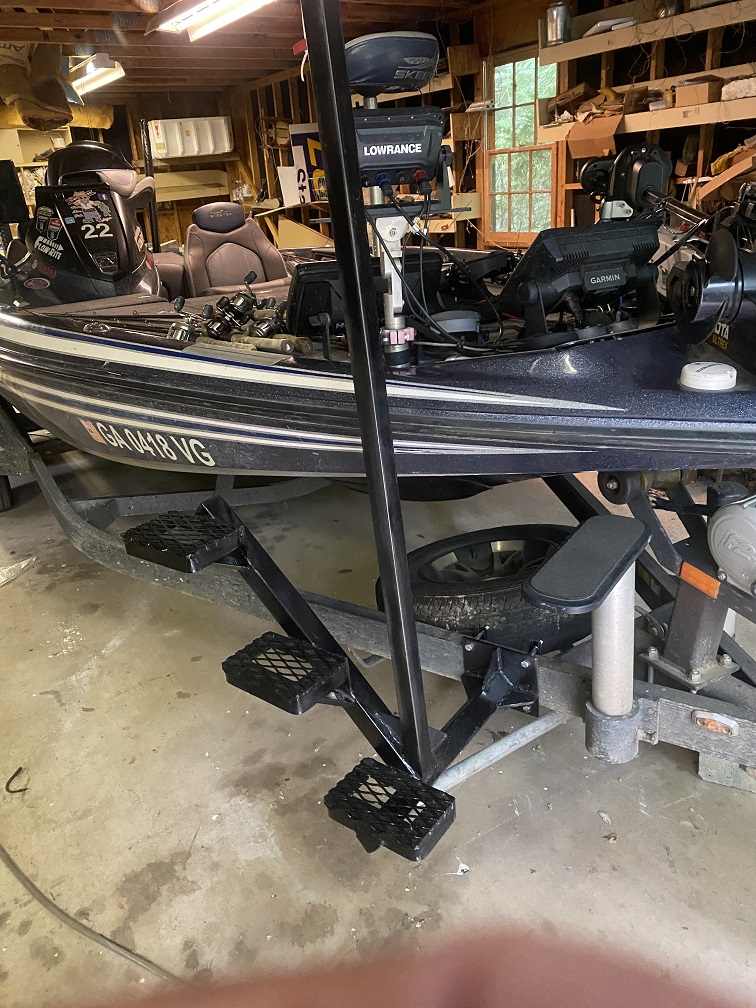
James installed these on my boat last Sunday after our West Point tournment for $250! You can get some from him at 706-668-3459 cell or 770-854-8713 home.
St Croix Victory Rods and the Koza Family

PARK FALLS, Wisc. – Carter Koza is senior at Mount Paran Christian School in Kennesaw, Georgia. His sister, Lee Rose Koza, is a sophomore at Carson-Newman University in Knoxville, Tennessee. Both siblings have fished competitively for the past several years, and credit their father, Jamie, for their love of fishing and drive to compete.
“My dad fished tournaments ever since he was a little kid, so he got us involved early,” says Carter, adding that their dad also runs a tackle shop. “We were surrounded by fishing all the time. We’d go to school, then to the shop, and the rest of the time we were fishing,” adds Lee Rose, who admits that her decision to fish competitively did not come without challenges.

“I really had to get over my fears of jumping into the sport. Carter was already fishing and having success on our high school team, but I didn’t join until my junior year,” Lee Rose says. “It took a lot for me to make that leap of being one of the only girls in high school bass angling in the State of Georgia. But I’m proud and grateful that I did. Putting myself in that boat and fishing in a male-dominated sport turned out to be a great decision and I consider that my first personal fishing victory. My second was when Carter and I fished together and won Angler of the Year in 2019 – our last year fishing together as a team. When we got handed that Angler of the Year trophy for the whole entire State of Georgia, that moment was victorious; it was indescribable.”
Carter agrees, and dives deeper into what it takes to earn consistent success as a tournament angler. “We fish all over the place. Showing up to a new lake at a certain time of year, you’ve got to figure it out. It’s like a puzzle,” he says. “Being able to not only catch fish, but also have a good finish and cash a check in any tournament… that’s victory.”
Carter and Lee Rose have been partners with St. Croix for almost five years now. “Being able to work with a company that stands behind me, not only providing support but treating me like I’m a member of the family is another great victory,” says Carter. “My tournament career is still relatively young, but I know and appreciate how special St. Croix is as a company and am truly grateful to be a part of their team.”
Both Lee Rose and Carter were among the St, Croix pros who had early access to the new Victory Series rods for beta testing and input. “I’m really excited to see where this series goes,” Lee Rose says. “Being college and high school anglers, we are definitely on a budget. We can’t go spend $500 for a single rod, and a lot of other anglers can’t either. Seeing these American-made technique-specific high-performance rods being offered at such an affordable price with a 15-year warranty is a really big deal. For the weekend angler or someone striving to fish the Bassmaster Classic, these rods are attainable for almost anyone and will definitely help give anglers the upper hand on the water.”
| St. Croix’s all-new made-in-the-USA Victory Series rods were conceived and designed to deliver bass anglers more victories on the water – no matter how they’re defined. Featuring technique-specific lengths, powers and actions that yield lightweight performance with extreme sensitivity, durability and balance via an all-new SCIII+ material, eight new Victory rods are available right now at select St. Croix dealers and online retailer. Angler-friendly retail prices for these new, American-crafted Victory rods range from $180 to $200. |
| #stcroixrods #stcroixvoiceofvictoryLike the rods? You’ll love our lifestyle apparel. |
Learning Drop Shot Secrets with James “LJ” Harmon
Nine years ago I met James “LJ” Harmon at Lake Lanier to do a “Map of the Month” article. Since then I have kept up with him and his fishing at Lanier. The “LJ” in his name is for “Lanier Jim,” his nickname around the lake. He lives on the lake in a house back in a cove not far from Browns Bridge.
When I got in his boat for that trip, I was surprised to see he had only two rods out, and both had drop shot rigs on them. I found out that day how good he is with that rig and his Humminbird electronics. We caught many big spotted bass that day out of a few of the 1100 brush piles he had marked in his GPS.
LJ not only shares his tips and techniques online, he and his son Cory own Lanier Baits https://lanierbaits.com/ where sells his drop shot “Fruity Worms,“ worms he designed and has special colors just for drop shotting at Lanier. They work! I use them at Lanier and other lakes. He also sells other tackle there.
One big problem with drop shotting is line twist. The way the worm hangs on the line almost guarantees line twist each time you reel in. This past week he showed me a new rig he and his buddy and co-worker “Big Earl” developed.
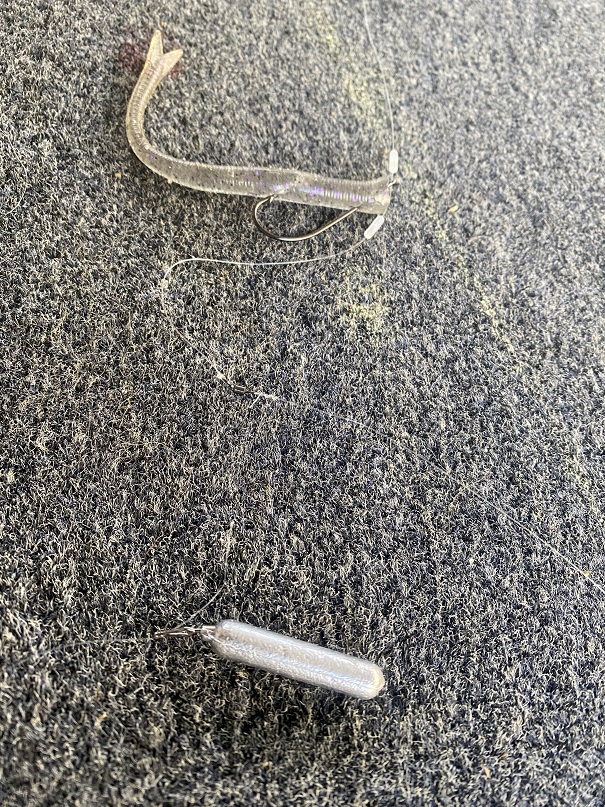
Rather than tying his hook to the main line as usual, LJ puts a bobber stopper on his line, then the hook followed by a second bobber stopper. The tiny, clear bobber stoppers he uses does not bother the fish but hold the hook in place. They will slide on the line so you can adjust the length of leader quickly without retying everything. When you set the hook they will slide down to the swivel but LJ says this does not interfere with hooking the fish.
At the end of his main line he ties a tiny, strong swivel, then a short light leader to the other end of it. The leader is tied to a drop shot sinker with another swivel at the top. The light leader above the lead allows him to break off the sinker when it gets hung without breaking off hook and bait, and the two swivels also help prevent line twist.
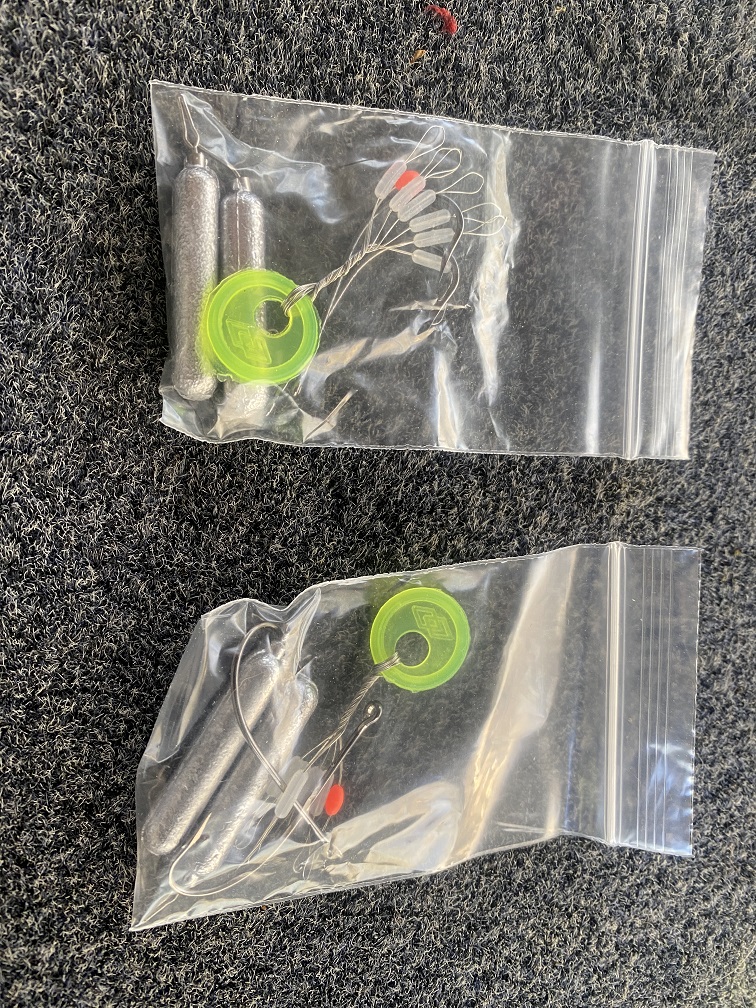
He sells the kits with six bobber stoppers, sinker, hook and swivel on his web site. It seems complicated, but tying a drop shot rig the usual way is just as complicated and this one allows a lot more options without a lot of effort.
LJ showed me this rig before installing a new Humminbird Helix 15 on my boat. As well as selling tackle, he guides on Lanier and installs electronics. He got me a good deal on this huge new depthfinder and did a very neat install, with all wires covered.
This unit with a 15-inch screen may help show bottom details better to my old eyes. And it may show me fish. LJ tried to show me how to read it, but using the demonstration mode is not like getting on the lake. He does trips on the water where he will tune up your electronics and teach you how to use them, too. I plan on going with him and doing that soon.
A trip with LJ will keep you entertained, too, if you have a thick skin. The better he knows you the harder he is on you, but he takes as good as he gives so it is in fun!
How To Catch April Crappie on Lake Weiss
Crappie fishermen know they are headed to the right lake when they get near Lake Weiss and start seeing signs proclaiming it is the “Crappie Fishing Capital of the World.” Those signs on the roads leading to Centre, Alabama give you an idea of the importance of crappie fishing in the area.
Lake Weiss on the Georgia/Alabama state line is an Alabama Power lake on the Coosa River. Its vast stump filled flats on the river and in major creeks offer crappie perfect habitat. And the state, local businesses and fishing groups work to make it even better. Weiss and Logan Martin, the next lake downstream, are the only two lakes in Alabama with a ten inch size limit protecting smaller fish.
The upper Coosa River extends into Georgia but to fish the main lake you will need an Alabama fishing license. If you are coming in from out of state you can get an annual license online starting at $50.25 with a couple of states a little higher. A seven day trip license is $28.35 unless you are from Florida. And you can bring the family and get a family seven day fishing license for $28.35 that is good for you and four immediate family members.
Groups like the Lake Weiss Improvement Association, made up of fishermen, businesses, Alabama Power and the state of Alabama work to improve crappie habitat on the lake by putting out brush piles and insuring size and number limits, 30 per fisherman per day, are observed. They also promote crappie fishing on the lake.
Mark Collins grew up near Weiss and got started fishing the lake for crappie when his parents bought a house on the Weiss when he was young. He has been guiding full time for crappie, stripers and bass on Weiss for 23 years. He has learned the lake well and knows how to catch crappie year round.
Mark also is a member of the Lake Weiss Improvement Association and helps pick the right locations for the group to put out cane brush piles. The Association also puts on a Crappie Rodeo with tagged fish worth a variety of prizes. The Rodeo is going on right now until the end of April and you can enter and get a badge from most local fishing businesses.
He is the only guide just about anywhere that guarantees “No fish, no pay.” He will even call clients and postpone trips when the crappie are not biting good. As he says, he wants their money, but wants it more than one time. And it works, most of his clients are repeat business, showing his skill and care for the folks he takes fishing.
When he is not on a guide trip Mark is usually on the water checking conditions and trying to find good schools of fish. He is on the water almost every day of the year. That is what it takes to really keep up with the fish and provide good trips for guide clients.
Right now is a good time to troll for crappie, one of the most efficient ways to catch large numbers of quality fish. Crappie are suspended over the channels of the river and major feeder arms from October through April and you can find schools of them around baitfish in deeper water. In the winter there are more fish out on the river but now most of them are headed to the spawning areas.
In late March through April the channels in Little River and Cowan and Spring Creeks are some of the best places to troll. Near the end of April they will be shallow in those areas and others and Mark catches them “shooting docks,” using his rod like a sling shot to propel the jigs under the docks for fish spawning around them and feeding under them.
He will continue to troll, too, but focus on stump beds in more shallow water. Then as the fish move back toward deeper water trolling works until they get on brush piles and stump beds on the river channel, where it is better to sit over them with tight lines almost straight down under the boat. That works through the summer until they start suspending again in October and trolling picks up again.
On Weiss you are limited to three poles per angler at one time. Mark does not troll more than ten lines at one time since that many are plenty to catch a lot of crappie and are much less trouble getting tangled and it is easier to manage them. He will take one to four clients at a time in his center console NauticStar boat equipped with a Minkota IPilot trolling motor.
Using B & M rods of six to 14 feet long allows Mark to cover a wide swath of water while trolling. The longer rods are put in rod holders at the front of the boat with shorter rods toward the back. The shortest rods are used to troll straight behind the boat.
A reel with a smooth drag is important when using light line and Mark likes the Dawai spinning reels for his fishing. They handle the light line well.
Mark keeps it simple when trolling. He uses one size Jiffy Jig and varies the color based on water color. In clear water he goes with translucent colors but the more stained water he goes to either darker colors or bright colors like yellows and chartreuse.
Jiffy Jigs are made in Valida, Georgia and you can order them for $6 a dozen from their web site: http://www.jiffyjigs.com/. They make a wide variety of colors and sizes to meet any kind of fishing you prefer.
And he uses six pound Ande monofilament line on all his reels. If he wants his jigs to go deeper he adds a split shot to the jig rather than going to lighter line or heavier jigs. Mark says it is much easier to crimp on a split shot or remove it than to retie all his lines with different size jigs.
Monofilament line has some stretch to it, which is important to keep from tearing the hook out of the fish’s mouth. Crappie are called “papermouths” for a reason. And a long limber rods helps with this, too.
Boat speed is critical and with a good depthfinder and GPS you can control it, or do as Mark does and set his IPilot to maintain the right speed. Mark likes the user friendly Garmin electronics to find fish and bait and to watch his speed. In late March he is trolling about 10 to 14 feet deep in the feeder streams for fish suspended at that depth over deeper water.
When the water hits a consistent 58 to 60 degrees the fish will move to the shallow stump flats, usually in fairly early April. Then he puts a cork on is line and slowly trolls water four to eight feet deep where they are holding around stumps. The cork keeps the jig above the stumps.
Keeping your bait above the stumps keeps you from getting hung, but you have to keep your jigs above the fish no matter how deep they are holding. Crappie will come up to eat a bait, sometimes several feet when they are real aggressive, but won’t go down to hit. That is why it is important to see the fish and what depth they are holding on your electronics and keep your bait just above them, as close to just above them as possible.
Mark starts trolling at .8 miles per hour then varies it depending on what the fish tell him. He will vary the speed from that starting point until he starts catching fish, then stays at that speed. It is hard to keep a constant speed in the wind without a trolling motor that will hold it or constantly watching your GPS.
Often while trolling for crappie you will hook a big striper, catfish or bass. Unlike many guides that instantly break off those fish to keep them from tangling all the other lines, Mark quickly reels in his other lines so his clients can have the fun of fighting a big fish on light line and rods. And they usually land them. The only exception is when a big gar eats the jig. They will almost always cut the line with their teeth.
Mark says many people plan a multi-day trip to Weiss and go out with him the first day of the trip to find out where and how deep the fish are holding. That is a good way to get current conditions and information on the lake.
Be warned you will have a lot of company trolling for crappie. It is not unusual for over a dozen boats to be trolling a small section of the river or creek. Many folks don’t go looking for fish, they just look for groups of boats and join them. Be considerate of others when trolling.
On his website below Mark has the GPS coordinate for the brush piles put out by the Weiss Lake Improvement Association. He makes sure they are put in places the fish already use to enhance those places. There are about 17 in Little River and 20 in Spring and Cowan Creeks. Five local high school fishing teams help put out the brush piles and the state of Alabama and Alabama Power help with expenses. They hold fish from late May through the summer.
Mark will show you exactly how he catches crappie year round or stripers and hybrids mostly in June and July by trolling live shad for them. You can book a trip with him by visiting his website at http://www.markcollinsguideservice.com or call him at 256-779-3387. He charges $300 per day for an eight hour trip for one or two people and $100 each for an additional one or two people, up to four total. A half day trip is @225 for one or two with each additional angler $100 more.
Mark does not clean fish for his clients but there is a cleaning service at Little River Marina and Resort. Mark goes out from there and they are the only full service marina on the lake. They have rooms for out of town fishermen as well as anything you need for fishing.
Bass fishermen will be excited to know the state of Alabama is stocking Florida strain largemouth in the lake. If you prefer bass fishing Mark can fill you in on current details on them, too.
If you are a crappie fisherman plan a trip to Weiss in the next few weeks. Hire Mark to show you exactly how to catch crappie. You can’t go wrong with a trip to Weiss, after all it is the “Crappie Fishing Capital of the World!”
Garmin Striker Cast GPS Review
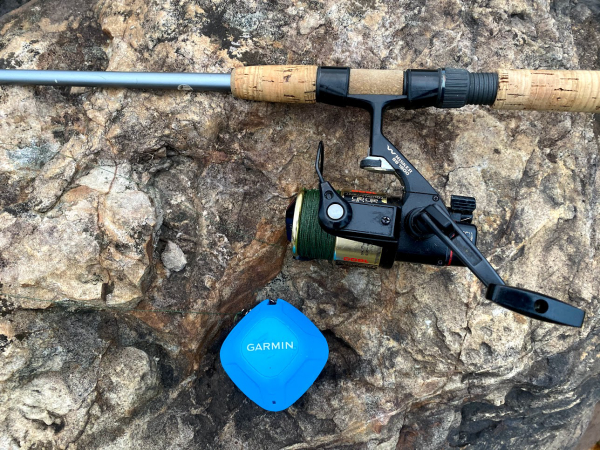 Frank Sargeant, Editor from the Fishing Wire Garmin Striker Cast GPS—Castable Sonar For the many anglers around the country who fish from shore, piers or docks, it’s always a bit of a mystery how deep the water is within casting range, what structures are on the bottom, and where the fish are in relation to that structure. Without a sonar/GPS screen to tip you off, you’re fishing blind. Garmin’s Striker Cast GPS puts fish-finding technology into the hands of these anglers, at a very affordable price. It provides quality sonar and GPS on any smart phone. 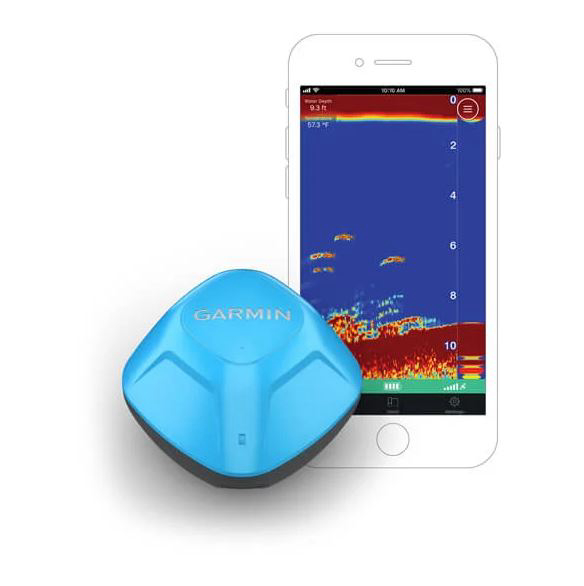 The whole system is encased in a hard plastic housing about the size of a tennis ball. The unit turns on when it’s immersed in water, and links via Bluetooth to your smart-phone once you download the Striker Cast app. You attach the device to your fishing line, cast it out to the water you want to check and presto, a sonar screen appears on the phone. The whole system is encased in a hard plastic housing about the size of a tennis ball. The unit turns on when it’s immersed in water, and links via Bluetooth to your smart-phone once you download the Striker Cast app. You attach the device to your fishing line, cast it out to the water you want to check and presto, a sonar screen appears on the phone.The Striker Cast is about the size of a tennis ball. It can transmit to your phone from up to 200 feet away. The device weighs about 3 ounces, so it’s not something you’re going to throw on your light action spinning rod. And it would be easy to pop your line and lose the Striker if you got a dead-stop backlash on a hard cast. I tied it on with 65 pound test Spider Wire braid on the heavy duty snap swivel, just to be sure—that braid will hoist a couple of concrete blocks, so it’s not going anywhere. 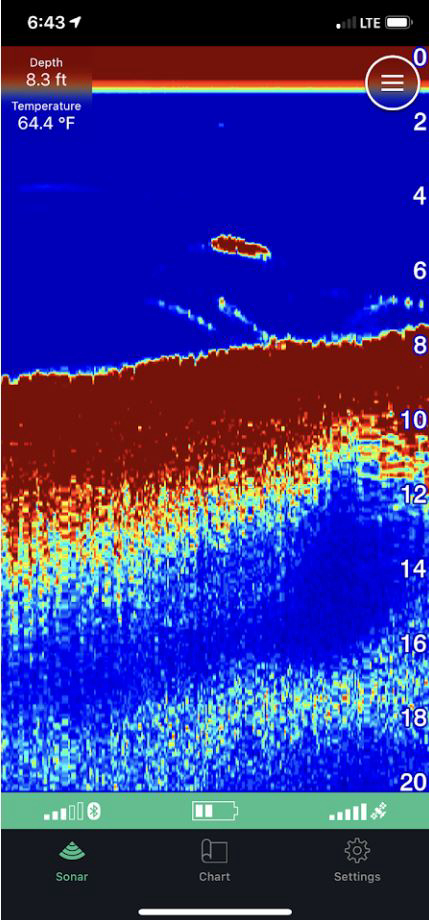 Here, a bass hanging over tree limbs on bottom at 8 feet shows clearly. Note the water temperature and depth digital readout on the upper left. You don’t really cast the Striker—it’s more like lobbing a tennis ball, unless you put it on a 10-foot surf rod. I used a heavy action Shimano Sienna 7-footer and a 4000 size reel that would whip a kingfish, and it was about right. Manipulating the rod, reel handle and your smart phone all at once is a challenge unless you have three hands. The way I worked it out was to hold the rod in my right hand, the phone in my left and also lightly hold the reel handle. I then rotated rod and reel to retrieve line—it sounds more difficult than it is once you’ve made a few casts. As with any sonar, the faster the transducer moves, the more the terrain and fish below are compacted, while the slower things move the more they are stretched out. Thus, a foot-long bass going slow under a fixed transducer can look like a 40-pound pike. However, you quickly learn to adjust. The system automatically sets range and gain, or you can adjust both manually at the tap of a virtual scale. Bottom shows red/yellow, water blue, fish and structure also red if large, yellow if small or scattered. The screen has digital depth and water temperature readouts on the upper left. The unit also has a very accurate GPS system which allows you to map the area you are graphing. Walk all the way around your favorite pond, casting every 50 feet or so as you go, and it draws a chart of all the water you can reach, complete with depth profiles. You can name and save this, and you can also share it publicly. (I suspect that’s a function not many serious anglers will use!) The chart was made by repeated casts with the Striker Cast. The opening at the center was where the author walked around a creek, so there’s no graph of that area. The transducer is not like your boat floating over a fish, which usually flushes anything shallower than 10 feet in most lakes. Fish are not aware of it, and in fact I had a catfish come up and bump it apparently to see how it tasted. So, you can graph an area with a couple casts, spot fish, tie on a lure that gets to their appropriate depth, and hopefully connect.  The Striker Cast would also be very useful for ice fishers—it’s compact, easy to carry, and would give you a quick read of what’s happening at each hole you open. The Striker Cast would also be very useful for ice fishers—it’s compact, easy to carry, and would give you a quick read of what’s happening at each hole you open.After saltwater use, you’ll want to rinse the connections thoroughly before hooking it up to the included USB charging wire—corrosion is not your friend. I wished the charging LED was a bit easier to see or had an alternate color when fully charged, but that’s a minor inconvenience. The battery lasts 10 hours with a full charge. Here’s a useful video that teases out the many functions: https://www.youtube.com/watch?v=NEew_HQ90lY. The Garmin Striker Cast GPS goes for about $180, and it’s sized about right for a stocking stuffer. Check it out here: https://buy.garmin.com/en-US/US/p/665274 |
Learn Saltwater Fishing in Florida with Virtual Clinics
| from The Fishing Wire Want to learn how to saltwater fish in Florida? Join the Florida Fish and Wildlife Conservation Commission (FWC) for a series of free Virtual Saltwater Fishing Clinics for beginner anglers age 16 and older to learn how to saltwater fish and help conserve our marine resources for the future. Discover the importance of fisheries conservation and stewardship through the fun and exciting sport of fishing! You’ll be taught basic fishing skills and knowledge that can be used, shared and built upon for a lifetime of catching Florida memories with those you love. Fishing clinic sessions will prepare you for a day out on the water to enjoy the amazing variety of saltwater fishing opportunities Florida has to offer. Sessions will include topics on conservation, rods and reels, tackle, baits, rigs, knot tying, habitats, fish handling, best practices and additional resources. Registration is required and must be completed two days prior to the session date. Participation is limited to 50 anglers per course; anglers who register after the 50-person limit has been reached will be put on a waiting list. Anglers must use Microsoft Teams to participate. Ready to dive into a course on saltwater fishing? Virtual Saltwater Fishing Clinics are offered as a course that includes seven separate 1-hour sessions held every Tuesday evening from 6:30-7:30 p.m. ET for seven consecutive weeks. Anglers must be able to attend all seven sessions. Each course has the same content, so anglers only need to register for one course. Those who attend a course will receive a free starter tackle box. Register for a Virtual Saltwater Fishing Clinic seven-week course:Jan. 19 (includes seven sessions)March 9 (includes seven sessions)April 27 (includes seven sessions) Don’t have enough time to commit to a seven-week course? Participate in our Mini Virtual Saltwater Fishing Clinics instead and you’ll learn about saltwater fishing and conservation in a bite-size format to fit your busy schedule. These 90-minute virtual events will be held once a month on a Thursday evening from 6-7:30 p.m. ET. Each session has the same content, so anglers only need to register for one single session. Register for a Mini Virtual Saltwater Fishing Clinic session:Jan. 28 (single session)Feb. 25 (single session)March 25 (single session)April 22 (single session)May 13 (single session)June 10 (single session)Can’t carve out time to participate in either format right now? Don’t worry, later this year we’ll post videos of these virtual clinics on our webpage so you can take the course sessions at a time and pace that works best for you. Have questions? Visit MyFWC.com/Marine and click “Virtual Saltwater Fishing Clinics” under Get Involved or contact Marine@MyFWC.com to learn more. Read more |
Sunline Fluorocarbon Line Review
Product Review
Sunline Fluorocarbon Line
Good
Sunline Fluorocarbon Line comes in 17 different types for different applications. Its entry level line, Super Fluorocarbon, is a good choice for general fishing. At the top end, Super FC Sniper, is for the tournament fisherman depending on every strike for his living.
Fluorocarbon is a very low visibility line with little stretch. It sinks, so it is not suitable for all lures, for example topwater lures do not work well with it.
A variety of the types of line are for specific situations. Dostrike FC is designed for fishing bladed jigs. Crank FC is made for fishing crankbaits. Both lines are designed with some stretch for those baits.
The Night line is made to be visible when using a black light at night. The Super FC Green Sniper has green color in it to help the fisherman see it above the water but is much more visible underwater to fish, too. Flipping Fluorocarbon has colors to be visible to the fisherman and is abrasion resistant.
I started using Sunline Fluorocarbon years ago after doing a Map of the Month article at Lake Lanier with Eric Aldrich. The first stop, he lowered a drop shot bait to the tip of a blowdown in 30 feet of water. When he set the hook, he sawed the fish back and forth several times in the limbs and landed a three-pound spot.
I said he must be using heavy line for dropshot but he responded it was five pound Sunline. I thought it was a fluke to land that fish, but later in the day he did the same thing in a 35-foot-deep brush pile, sawing back and forth then landing a 3.5-pound spot.
I figured if five-pound Sunline line would do that, I could tow my boat with 12-pound line.
I fish a jig and pig on 14 pound and a shaky head on 12-pound Super FC Sniper or Super Fluorocarbon. It holds its knot as well as any fluorocarbon and I have never been disappointed in it. I think I get more strikes with fluorocarbon than I would with other line when fishing slow moving baits.
Bad
Sunline Fluorocarbon Line is more expensive than many other fluorocarbon lines.
Fluorocarbon line does not stretch like monofilament. When I switched to 12-pound fluorocarbon, I broke my line several times on the hookset until I loosened the drag enough to slip a little on the hookset.
Fluorocarbon is also notorious for knot slippage. With Sunline and any other fluorocarbon, if you do not tie a good knot suitable for fluorocarbon you will lose fish.
Cost
Sunline fluorocarbon line lists for $19.99 to $39.99 for a 165 to 200-yard spool. Bulk spools are available at slightly less per yard for some types of it.
St Croix Rod Sale
| Sale is LIVE! St. Croix rods deliver distinct advantages on the water. This year, give the anglers on your list what they really want… St. Croix pride and handcrafted performance. Whether shopping for others or taking advantage of deep savings to add to your personal rod collection, St. Croix has anglers covered with our special two-week Holiday Sales Event, starting this Friday, December 4th and running through the 20th. St. Croix’s Holiday Sales Event will run from 7:00 AM CDT on Friday, December 4th through 10:00 PM CDT Sunday, December 20th. Shoppers at www.stcroixrods.com/collections/rod-shopper can take 40% off select retired Avid Salmon & Steelhead and Wild River rods; 40% off select retired Sole fly rods; 30% off retired Mojo Inshore and retired Tidemaster rods; and 25% off retired Mojo Ice, Triumph, Triumph Salmon & Steelhead, Triumph Surf, Triumph Travel and Reign rods and even some left over combo’s from the Black Friday sales event! |